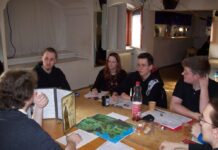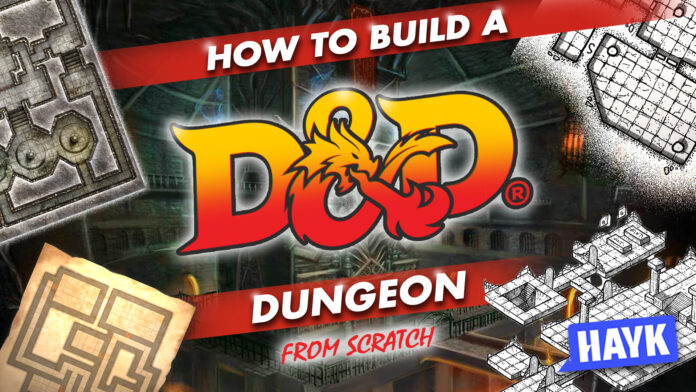
Any game of D&D won’t be complete without a dungeon. Whether the dungeon is a couple of blocks assembled or cardboard pieces neatly positioned, it will still be a place of mystery and danger for all players.
In this article, you will learn how to build a D&D dungeon from scratch. While our focus is physical sanctum or dungeon creation, we will also offer some general and game master tips about online dungeon crafting using traditional designing software.
Contents of this Page
Room Dungeon Model: Tips on How to Build Your Dream Dungeons
Roleplaying Tips: Choose A Dungeon Theme or Style
Figuring out the dungeon theme is the first step of any room dungeon model project. There are many types of dungeon themes, and they depend on the nature of your campaign. In addition, any other dungeon master guide can be more complex to build than others.
These are some popular dungeon themes or styles for RPGs:
- Medieval – worn-out stone blocks, moss, and dark rooms
- Horror – worn-out stone blocks, bloody imprints, and lots of ghosts
- Elemental – a specific dungeon based on four elements: fire, water, air, and earth
- Desert – sand blocks, runes, and lots of traps
- Steampunk – this is like a dungeon extension of a steampunk laboratory
- Futuristic – this is like a collection of spaceship corridors filled with aliens and rogue droids
Create A Layout
If the dungeon theme is the overarching concept, the layout is the blueprint. Nowadays, it’s easy to make dungeon blueprints with the help of designing software like GIMP or Adobe Photoshop. You can even use online dungeon generators and layouts as templates for your physical dungeon design.
While creating a layout, you need to ensure that all pathways are making sense. A long corridor, for example, won’t just lead into huge rooms with dozens of smaller paths unless there’s a big reason. Thankfully, you can reason out that the corridor was built with magic, and there are traps within.
Every room must have a purpose in your dungeon. Perhaps the room guarded by a Troll leads to a secret passageway, or there are multiple rooms linked using teleportation magic.
Layouts don’t need to be fancy. You can use ballpoint pens or markers to draw the dungeon layout. Once you’ve started setting the dungeon’s essential pieces, you can now be fancy like an artist.
Tie the Dungeon to A Story
One of the most crucial elements of dungeon crafting is a story. Without storytelling, a dungeon will feel static, like an artificial display on a convention table. If the dungeon is not the core of your campaign story, it can directly link to the antagonist’s plans. Maybe the antagonist keeps important prisoners in the dungeon, or he is using the dungeon as a phylactery!
The dungeon denizens can even have smaller stories connecting to your general plot. Think of these stories as side-quests that your players can take. Always remember that a dungeon denizen should have a reason to stay inside the rooms. You can tie the reason to almost anything: loyalty, greed, boredom, habit, or just unfortunate circumstances.
Here’s another angle: a dungeon’s story can shape its theme. The design will follow suit if you believe that the dungeon’s level might be chaotic. At the end of the project, your dungeon will look like a place of pain and hopelessness. It depends on how you intend to reveal the dungeon to your players.
Prepare Your Tools and Materials
Before starting your project, you need to prepare the right tools and materials. Remember, you don’t need expensive tools to build a dungeon. You can also work with basic materials, but high-quality choices will make your dungeon fantastic.
These are some tools and materials to get you started:
- Scissors, small cutting tools, scale modelling knives, and razor blades
- Polymer clay for terrain details
- Weathering paints and acrylics
- Styrofoam cutouts for ramps and walls
- Small wires for connecting stuff
- Cardboard pieces
- Assembled minis (if you prefer to use minis)
- Brushes
- Airspray tool (entirely optional if you’re a beginner)
If you want to save time, you can purchase a dungeon crafting kit containing hundreds of cutouts representing dungeon parts. It’s easy to assemble the cutouts, and you can even reposition them in any way you want.
Best Items to Help You Build A Fantastic D&D Dungeon
Are you looking for the best items to support your D&D dungeon crafting journey? Well, we got you covered. First, we reviewed some of the best items, tools, and materials, so you can then purchase them in just a few clicks.
WizKids WarLock Tiles
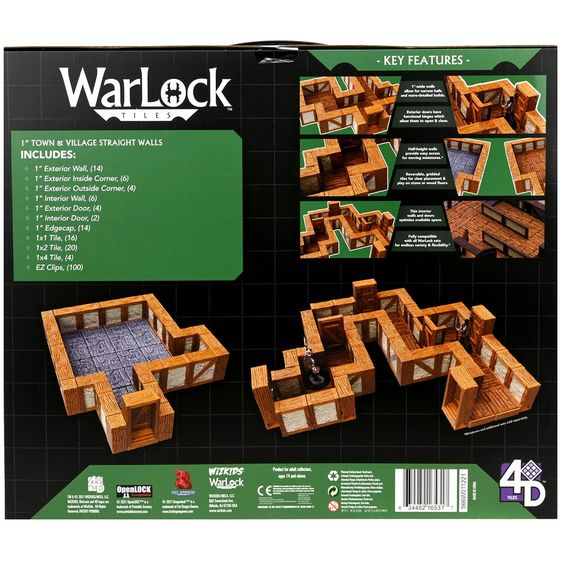
Brand: WizKids
Dimensions: 5 x 3 x 2 inches
Colors: Multiple
Rating: 4/5
The WizKids Warlock Tiles is a great starter kit for any busy DM. Right out of the box, it’s easy to assemble the modular dungeon tiles. You can even add extra details using paints or common materials because of the tiles’ neutral-grey color.
Every tile piece of the WarLock kit has excellent detail. The linings are precise, and even the hinges in every door match the aesthetics of a weathered dungeon. One minifig is also included, ready to test a small dungeon adventure!
The only problem with the WarLock tile kit is design inconsistency. Some dungeon parts are smaller than others, and some doors have uneven sizes. The design inconsistency is a mild thing, however. It won’t disrupt any level of immersion in any of your player.
MulWark 16-pc Precision Knife Set
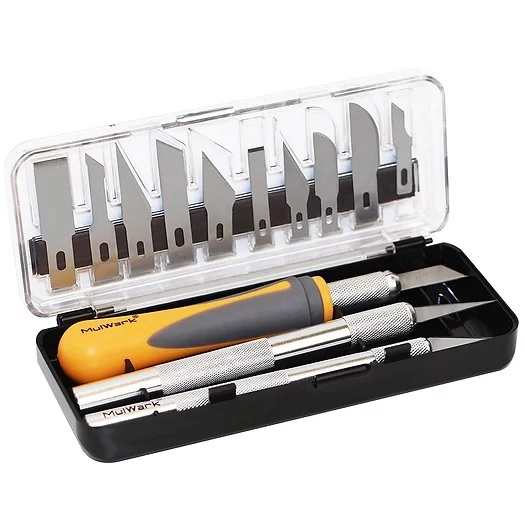
Brand: MulWark
Dimensions: 6 x 2 x 1 inches
Colors: Multiple
Rating: 4.3/5
A wise dungeon crafter will always have a set of multiple cutting tools. And in this case, one of the best tool kits you can find is the MulWark 16-pc hobby knife set. The knives in this MulWark set are durable carbon steel and can cut through most hobby pieces or materials.
The MulWark knife set contains sixteen knives with various purposes and designs. For example, the standard angular knives are great for all-around cutting, while chisel knives can cut delicate portions evenly. On the other hand, Sharp stencil blades will allow you to make intricate details on surfaces.
The MulWark knives have a problem with loose handles. Before using any blade, make sure that you’ve fitted it correctly to a handle. Otherwise, the blade might fall out or slide down. Also, not all knives in the MulWark kit are sharp. Some are dull and require consistent filing or sharpening.
Extruded Gaming Tawny Crates and Barrels
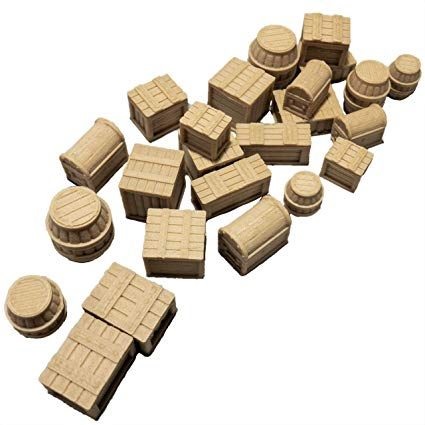
Brand: Extruded Gaming
Dimensions: 4 x 4 x 1 inches
Colors: Dirty brown
Rating: 4.4/5
Have you ever seen a dungeon without chests, crates, or barrels? If you answered YES, then that type of dungeon is not worth anyone’s time! Whether you believe it or not, dungeoneering and spelunking are driven by small chests filled with different rewards. So if you need barrels and chests, you can order a Tawny barrel kit from Extruded Gaming.
The chests and barrels from the Extruded Gaming kit have excellent texture designs. They look old from a single glance, and they are even proportional to the sizes of most miniatures. You can put the barrels and crates as obstacles in combat, while the chests can depict treasure hoards or hungry Mimics.
Some minor problems of the Extruded Gaming barrel kit are rough surfaces and uneven parts. You can file these areas if they bother your dungeon detail. Otherwise, the inconsistencies won’t affect the gameplay at all. The Extruded Gaming kit is also pricier than other kits, but you’re paying for quality anyway.
FAQ About Dungeon Crafting
Is it difficult to create a D&D dungeon?
Answer: It depends on your general crafting experience and sense of creativity. Just remember that you don’t need fancy materials to build a dungeon. Instead, focus on the bare necessities such as pathways, walls, ramps, and doors. Most of the time, you can use cardboard and paper to set down the foundations of your dungeon.
What materials are needed to build a D&D dungeon?
Answer: The materials depend on the style of the dungeon you want to build. Commonly, you can use cardboard, foam, plastic pieces, cloth strips, molding clay, and even small pieces of wood. Lego blocks are also great alternatives if you don’t have authentic dungeon crafting materials.
How many treasures should I include in a dungeon?
Answer: You can include as many treasures as you want in dungeons give players some edge, but you should also consider the element of balance in any campaign. Some treasures can make characters totally powerful, while others are just valuables that can be sold. As a rule of thumb, whole room dungeons floor can have a minimum of five magic items per.
Can I put different types of enemies in my dungeon?
Answer: Well, you should! However, remember that enemies should have a reason to be in the dungeon. They should also match the dungeon’s general theme. For example, you can’t just put magma-based creatures inside an ice dungeon. Organize everything from the theme to the story to incorporate the right types of enemies in your dungeon.
What are some of the best and most challenging dungeon enemies?
Answer: Golems are known to be challenging in dungeons because they are unrelenting, immune to most damage types, and also resistant to many conditions. A Beholder is also a challenging monster because it can unleash multiple rays and the infamous anti-magic cone. Lastly, Kobolds are insanely dangerous because of their capabilities of setting up deadly traps in the dungeon.
How can I make my players interested in dungeon-delving?
Answer: Making this work requires you to use some ‘motivation hooks’ to capture the interest of your players. These hooks can be riches, glory, fame, magical exploration, or anything tied to the players’ backstories. If the motivation hooks don’t work, try to introduce a series of threats that can only be resolved by exploring a dungeon attached to a specific purpose or goal.
Conclusion
Building a D&D dungeon shouldn’t be too tricky at all. Similar to running an Elden Ring theme dungeon, start small by focusing on primary materials and tools. Also, don’t hesitate to mimic other dungeon crafting techniques introduced by D&D artists. Just enjoy the process, and you can soon build a fantastic dungeon for your D&D campaign!
Do you have an excellent D&D dungeon or character art ideas? Please share it in the comments below!


